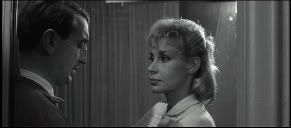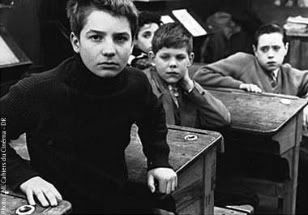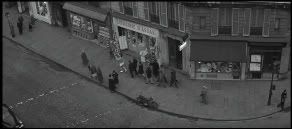|
The 400
Blows |
|
Synopsis Analysis The trials of the movie's young protagonist are usually well realized and, as a result, frequently arouse a poignant sense of sorrow in the viewer. The director, by depicting, in a number of telling moments, how Antoine has been marked as a troublemaker at school and how he endures an often unpleasant home life, enables the moviegoer to enter into the youth's world and to suffer the various hardships, miseries, and humiliations he does. The boy's relationship with his mother is evoked with particular finesse. At different times, Truffaut reveals that woman denigrating her son while he can hear her or casually committing adultery even though she knows that Antoine has seen her. In other moments, the director shows her expressing her love for the boy or pleading with him to mend his behavior, and, on one occasion, he even lets the youth speak directly to the camera and tell the viewer about how his mother had wanted to have an abortion when she discovered she was pregnant with him. All these incidents make the moviegoer aware not only of Antoine's mother's feelings, but also of how these affect her son. Truffaut does not, however, focus exclusively on this single relationship, but additionally exposes his protagonist's interactions with other persons in his life. For example, the director introduces the viewer both to the boy's kindly step-father and his harsh and judgmental teacher. He allows us to see how the former, despite his love for his family, is frequently exasperated by Antoine's behavior and is never able to satisfy his wife, and how the latter, because he is always ready to assume the worst about Antoine, repeatedly persecutes him while he is at school. Both these individuals enrich the tale Truffaut tells and contribute to its dolorous effect. Despite the often sad circumstances of Antoine's life, his existence is not, by any means, filled wholly with misery. In fact, the moviegoer is given numerous opportunities to delight in the youth's various adventures and passions. He thus feels the same excitement the protagonist is shown as feeling when the latter is introduced to the writings of Balzac and the same thrilling sense of danger the boy is depicted as experiencing when the he hides in his best friend's house or steals either a typewriter or a bottle of milk. What is more, the director has scattered throughout the film a number of genuinely appealing, even lovely images. At one time or another, Truffaut unveils to the viewer visions of Antoine and his best friend running down the steps in front of Sacré-Coeur, of columns of children marching between rows of trees, of different boys fighting and playing in a schoolyard, and so on. Sadly, as charmingly realized as these sequences are, most of the film is, frankly, visually pedestrian, and, because it is not consistently beautiful, I cannot say that The 400 Blows really approaches greatness. I do not believe I am being unduly harsh in saying this since a movie's overall quality is inextricably linked with its visual appeal. In fact, at whatever moment a movie does not present the viewer with a beautiful image, at that moment it is flawed as a work of art. Film as a medium is obviously a combination of a number of different elements. Nevertheless, while a given movie may or may not incorporate literary, musical, narrative, or other qualities, it always has a visual component. If it does not, it is not a film. This being the case, claiming that a movie can be a complete success while being visually pedestrian is like asserting that a painting can be a success despite its being ugly or even merely uninteresting to look at. Although a film may still have virtues even though it is not visually attractive, without such beauty, it cannot but be flawed. Just as a gorgeously colored painting of clumsily proportioned figures cannot be said to be perfect even though it does have certain virtues, so a film, though it is narratively engaging or musically delightful, is inevitably flawed if it is not visually appealing. In a very real way, a movie is like a series of paintings presented to the viewer in rapid succession and every one of these tableaux that is not stunning detracts from the quality of the whole of which it is a part. Even if The 400 Blows were more consistently attractive, however, the film's unremitting realism prevents it from rising above the ordinary. Rather than allowing the moviegoer to submerse himself in the movie as it exists in itself, the director makes a banal, simplistic attempt to fool the viewer, to make him think that he is looking not at the film's images themselves but through them, at individuals somehow living in a world that is being manifested on the movie screen. With such an approach, Truffaut strives both to trick the viewer into sympathizing with his characters as though they were real persons and to convince him to draw from their experiences lessons which can be applied to his own life. Such almost Puritan limitations, rather than transforming The 400 Blows into a masterpiece, instead dampen even its other virtues. It is, consequently, a very accomplished, but very bourgeois work. As enamored as a person may be of cinematic realism, unless he is naturally stupid or mentally deranged, he cannot, for more than the briefest of moments, forget that the characters he is watching on screen are fictional creations. Consequently, whenever he relates to these phantoms as though they were real individuals existing outside of the movie, he is certain to be awakened from that delusion before more than the briefest of moments has passed. The emotional reaction aroused by such an approach is, therefore, inevitably unstable and unsatisfactory. If, however, the director does not try to trick the moviegoer into involving himself with imaginary persons as though they had some life beyond the film, if, instead, he allows the viewer to immerse himself in the movie he is watching as it exists in itself, he will be able to elicit a response that cannot be overcome by any factor. Since the characters of a film exist merely as such, not as symbols which refer to something beyond themselves, their reality depends on nothing extrinsic. As a result, when the viewer is given the opportunity to approach a movie's characters without their being sullied with anything additional, with any extraneous, pseudo-representational factor that, by constantly sublating his experience, will incessantly distract him, he will be able to engage with and be captivated by their inherent beauty and self-sufficient appeal. The impediments that make realistic films ultimately unsatisfying cannot then arise to prevent him from relishing the emotions these characters arouse and from submerging himself completely in their existence. In fact, since a stable emotional reaction cannot be maintained by reducing a movie's characters to shadowy representations of externally existent beings, by deceiving the viewer, however briefly, and making him think that the characters do represent such persons, this approach simply cannot be as satisfying as can a more abstracted, stylized vision, which keeps the viewer always engaged with the work of art itself so that, like a man possessed, he is able to forget his own individuality, as well as everything else outside of that work, and lose himself in his enjoyment of another world. While such artists as Guy Maddin, Peter Greenaway, Jan Svankmajer, and Hayao Miyazaki have followed a deliciously stylized, aesthetically sensitive, and genuinely satisfying path, Truffaut, like the other directors of the French Nouveau Vague, has indulged in a lazy realism. By doing so, he has, inevitably, limited the quality of his work, including The 400 Blows, so that, despite its virtues, it never attains greatness. This is not to say, however, that The 400 Blows is a failure. The movie is always well crafted, generally engaging, and frequently touching. Even though the director's approach prevents the moviegoer from experiencing a sustainable emotional reaction to the protagonist's troubles, he does craft a number of incidents that are sure to touch the viewer and elicit a real sense of sympathy for Antoine. Being burdened with excessive realism and rarely being infused with any great beauty, The 400 Blows is not a masterpiece. It is, nevertheless, a consistently accomplished work that is certainly worth watching. Review by Keith Allen
Home Page / Alphabetical List of
Films © 2005 movierapture@hotmail.com Keith Allen. All rights reserved. |








